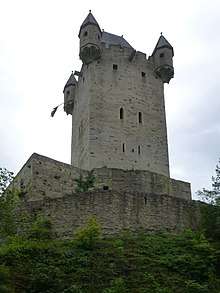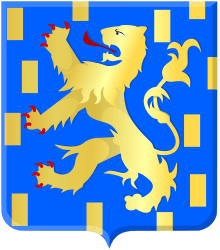Rupert III, Count of Nassau
Rupert III "the Bellicose" of Nassau, German: Ruprecht III. "der Streitbare" von Nassau († 23/28 December 1191),[1][2] was one of the earliest counts of Nassau. He was not without significance for his country. Important government decisions characterize him, but much more important is his more general political activity, making him one of the most striking princes of the House of Nassau.[3] He took part in the Third Crusade.
Rupert III, Count of Nassau | |
|---|---|
| Born | ? |
| Died | December , 1191 |
| Noble family | House of Nassau |
| Spouse(s) | Elizabeth of Leiningen |
| Father | Arnold II of Laurenburg |
| Mother | ? |
Biography


Rupert was probably a son of count Arnold II of Laurenburg and a woman of unknown name.[1][2][4]
Rupert is mentioned as count of Nassau between 1160 and 1190. He ruled together with his cousin Henry I and later with his cousin Walram I.[1][2]
Rupert was one of the trusted councilors of Emperor Frederick I Barbarossa, in whose surroundings we usually find him. In 1161 and 1162 he was with the emperor at Milan; whether he participated in the further trips to Italy in the years 1166 and 1167 remains questionable; likewise, participation in the unfortunate journey of 1174-1176 is, although likely, not traceable. It is also believed that he was present at the Diet of Pentecost at Mainz.[3]
In 1172 Rupert became Vogt of Schönau Abbey. Since 1182 he was Vogt of Koblenz. He is called Ruoberdus comes in the inscription of a coin, dated around 1175.[5]
With his cousin Walram, Rupert joined the Third Crusade (1189-1190), and in 1190 commanded the fourth army troop.[6] He was assigned an important task at the start of the journey. Together with his cousin Walram and Count Henry of Diez, he formed the accompaniment of Bishop Herman II of Münster, who was envoy to Byzantine Emperor Isaac II Angelos in the fall of 1188. The delegation did arrive in Constantinople, but was treated badly by the Byzantine Emperor and imprisoned in poor conditions.[7][8] They were set free as the crusade army approached.[9] On October 28, 1189, Rupert and his companions rejoined the crusade army at Philippopel.[7] Nothing is known with certainty about his further participation in the crusade; it seems that he stayed until the end of the siege of Akko and then died on the way back at sea.[3][10] He was succeeded by his son Herman.
Marriage and children
Rupert married in or before 1169[1] to Elizabeth of Leiningen († 20 June 1235/38),[4] daughter of Emicho III, Count of Leiningen.[2] As widow she used the title countess of Schowenburg.[1]
From this union came two children:[1][2][4]
Links
- Family tree of the House of Nassau
- Nassau in: Medieval Lands. A prosopography of medieval European noble and royal families, compiled by Charles Cawley.
Sources
- This article incorporates text translated from the corresponding German Wikipedia article, as of 2009-01-25, and the corresponding Dutch Wikipedia article, as of 2019-06-16.
- Dek, A.W.E. (1970). Genealogie van het Vorstenhuis Nassau [Genealogy of the Royal House of Nassau] (in Dutch). Zaltbommel: Europese Bibliotheek. OCLC 27365371.
- Hesselfelt, H.F.J. (1965). "De oudste generaties van het Huis Nassau" [The oldest generations of the House of Nassau]. De Nederlandsche Leeuw, Maandblad van het Koninklijk Nederlandsch Genootschap voor Geslacht- en Wapenkunde [The Dutch Lion, Monthly Journal of the Royal Dutch Society for Genealogy and Heraldry] (in Dutch). 1965 (11): 354–365.
- Lück, Alfred (1981) [1967]. Siegerland und Nederland [Siegerland and The Netherlands] (in German) (2nd ed.). Siegen: Siegerländer Heimatverein e.V.
- Sauer, Wilhelm (1889). "Ruprecht III., Graf von Laurenburg-Nassau" [Ruprecht III, Count of Laurenburg-Nassau]. Allgemeine Deutsche Biographie [Universal German Biography] (in German). Band 29. Leipzig: Duncker & Humblot. pp. 730–731.
- Sauer, Wilhelm (1896). "Graf Walram I. von Nassau" [Count Walram I of Nassau]. Allgemeine Deutsche Biographie [Universal German Biography] (in German). Band 40. Leipzig: Duncker & Humblot. pp. 776–778.
- Schwennicke, Detlev (1978). Europäische Stammtafeln. Stammtafeln zur Geschichte europäischen Staaten. Neue Folge [European Genealogies. Genealogies from the History of European States. New Series] (in German). Band I. Marburg.
- Setton, Kenneth M.; Hazard, Harry W.; Wolff, Robert Lee; Zacour, Norman P.; Whithed Baldwin, Marshall (2005) [1969]. A History of the Crusades: The Later Crusades, 1189-1311. Madison: University of Wisconsin Press. ISBN 978-0-299-04844-0.
- Vorsterman van Oyen, A.A. (1882). Het vorstenhuis Oranje-Nassau. Van de vroegste tijden tot heden [The Royal House of Orange-Nassau. From the earliest days until the present] (in Dutch). Leiden & Utrecht: A.W. Sijthoff & J.L. Beijers.
References
- Hesselfelt (1965).
- Dek (1970).
- Sauer (1889).
- Cawley.
- "Unser Krönchen - Band 1", Verlag Vorländer, 1983, p. 15.
- Lück (1981), p. 18.
- Sauer (1896).
- Setton, at al. (2005), p. 896.
- Vorsterman van Oyen (1882).
- Gislebert of Mons. (1869). Chronicon Hanoniense, hrsg. von Wilhelm Arndt in: Monumenta Germaniae Historica SS 21, p. 579.
- Cawley mentions that there is doubt about the first marriage of Lucardis to Gebhard of Querfurt.
| German nobility | ||
|---|---|---|
| Preceded by Arnold II Rupert II |
co-Count of Nassau (with Henry I and Walram I) 1160–1190 |
Succeeded by Herman |